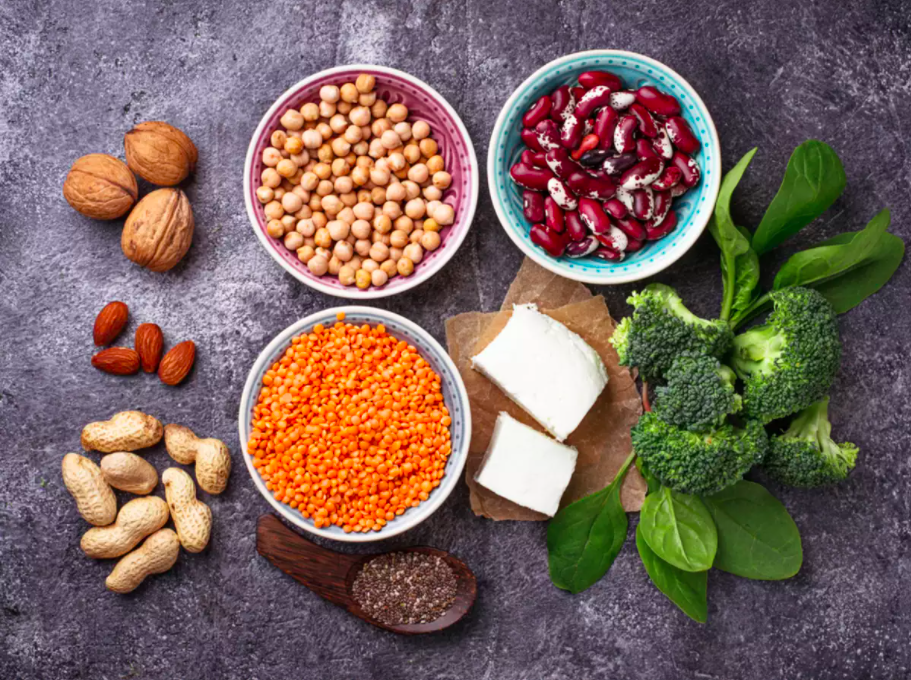By: Heidi Wagenbach
Thinking of going vegetarian? You’re not the only one– studies show that currently 3.2% of U.S. adults are vegetarian, meaning 7.3 million people of the total population follow the no-meat trend (Vegetarianism…). There are countless advantages to how vegetarianism helps the environment. A few include reducing global warming, saving large amounts of water, avoiding pollution, reducing destruction of rainforests as well as saving endangered species and ensuring environmental stability (Top Ten…). But what stops a lot of people from taking the jump into vegetarianism is giving up meat… and more importantly, the protein that comes with consuming chicken or beef. On average, women should consume 46 grams of protein daily and men should consume 56 (Protein Intake…).
So the second question is: how are vegetarians able to meet what their body demands while sacrificing the biggest protein contributors? Scroll down to find out!
I’m Nuts About You! (I Apologize In Advance For These Bad Puns)
A cup of peanuts contain about 50 grams of protein, whereas almonds and pistachios have 42. Cashews, walnuts, and hazelnuts have 30 grams per cup, while pine nuts, pecans, and macadamias are lower with 26, 18, and 14. Pumpkin and hemp seeds also contain a very good amount of protein per cup (60, 62) (Whitbread).
I Dair-you To Try This!
Similarly, a cup of cheese (Colby Jack, Mozzarella, Swiss) has 36 grams of muscle/energy booster, while cottage cheese contains 28. Finally, a cup of nonfat Greek yogurt has 22 and a cup of skim milk has 8 (Horton). By consuming dairy, you also get amounts of vitamin D and calcium.
How The Vege-tables Have Turned
I’m sure you’ve heard of the Impossible (or the Beyond) Burger (aka a plant-based burger)– seeing that restaurants are happily embracing this trend, and according to Eat This, Not That!, vegetarian burgers have the same amount of protein as regular burgers. On that note, one serving of hummus (⅓ cup) equals 7 grams of protein, while beans like kidney and black can give you 8 grams as well. Beans are also a great source of fiber!
An Eggs-cellent Reason To Be Vegetarian
Eggs are a popular staple of breakfast and for good reason: these little white spheres contain 14 grams of protein per serving (2). Speaking of the essential morning meal, oats have 4 grams of protein per 40 uncooked grams while whole grain bread has 3 grams. While not the highest on this list, every gram counts (How To…).
Something Fishy Is Going On…
A baked portion of fish (140 grams) contains 26 grams of protein, and also gives a plentiful amount of Omega-3 acids alongside vitamin A. Pairing that with a side of quinoa (which has 8) (How To…), that meal already serves as more than half your daily requirements.
On The Other Hand…
Animal protein varies from vegetable protein. For example, the amino acid count in vegetables is lower than that of meat. Another way to think about this is that meat has proteins that are similar to your own body and therefore are classified as “complete,” whereas vegetables are considered as “incomplete,” meaning they lack certain qualities found in poultry, beef, etc. A higher abundance of nutrients is found in animals, that’s why it’s a good idea to eat a balanced diet rather than limiting yourself to consuming only from certain sources. However, eating a good amount from a plant-based diet has countless health benefits such as lower risk of heart disease and diabetes (Brown).
In Conclusion:
To be vegetarian is an entirely optional way of living nonetheless, based on the above facts, avoiding meat is a good alternative to obtaining the necessary nutrients your body needs and simultaneously helping the world we live in. Especially since meat shortages are becoming all that more common, adjusting your diet will make these uncertain times easier to manage and helping yourself become healthier too. The bottom line is to eat from multiple sources to confirm your overall health and a longer life.
Works Cited
Brown, Mary Jane. Animal vs. Plant Protein – What’s The Difference?, Healthline, 17 June 2017,
www.healthline.com/nutrition/animal-vs-plant-protein.
Hickman, Kiersten. 13 Great Protein Alternatives If You Can’t Find Meat at the Grocery Store,
Eat This, Not That!, 29 Apr. 2020, www.eatthis.com/protein-alternatives/.
Horton, Brierly. 21 Ways to Get More Protein without Eating Meat, CookingLight, 20 Sept.
2017, www.cookinglight.com/eating-smart/clean-eating/easy-ways-to-add-protein-to-diet-without-meat.
How to get protein without the meat, British Heart Foundation ,
Protein Intake-How Much Should You Eat Per Day?, Healthline, 26 Oct. 2020,
www.healthline.com/nutrition/how-much-protein-per-day.
Top 10 Reasons Why It’s Green To Go Veggie, Down To Earth, 6 Nov. 2019.
Vegetarianism in America, Vegetarian Times, 10 May 2017,
www.vegetariantimes.com/uncategorized/vegetarianism-in-america.
Whitbread, Daisy. 16 Nuts And Seeds High In Protein, MyFoodData, 7 Oct. 2020,

